RENAULT CAPTUR 2017 1.G Owners Manual
Manufacturer: RENAULT, Model Year: 2017, Model line: CAPTUR, Model: RENAULT CAPTUR 2017 1.GPages: 248, PDF Size: 6.56 MB
Page 201 of 248
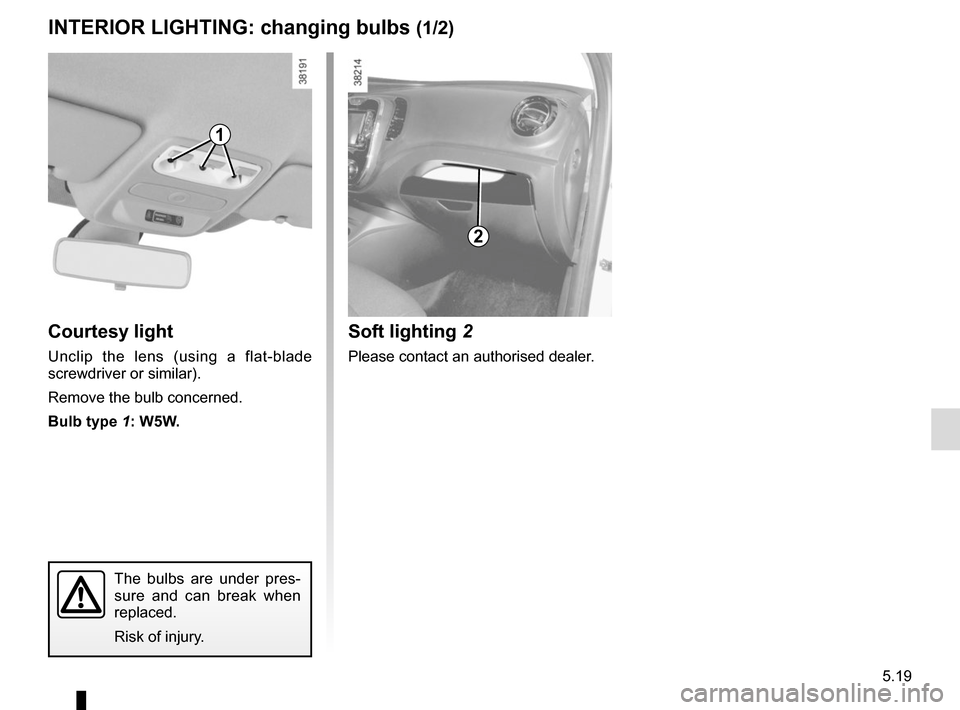
5.19
Courtesy light
Unclip the lens (using a flat-blade
screwdriver or similar).
Remove the bulb concerned.
Bulb type 1: W5W.
INTERIOR LIGHTING: changing bulbs (1/2)
The bulbs are under pres-
sure and can break when
replaced.
Risk of injury.
1
Soft lighting 2
Please contact an authorised dealer.
2
Page 202 of 248
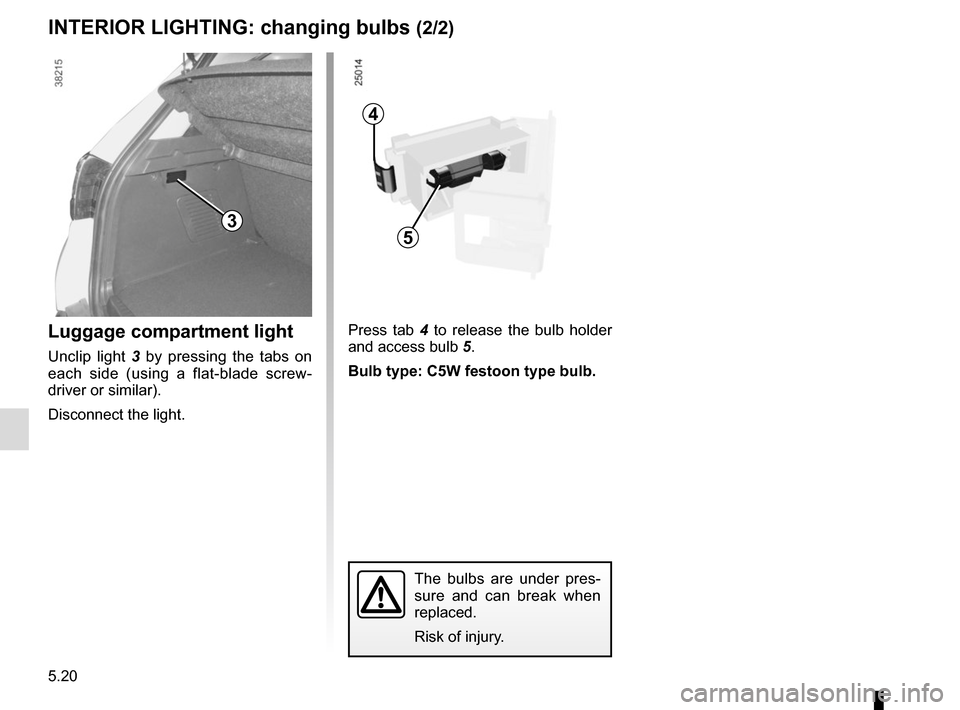
5.20
3
Luggage compartment light
Unclip light 3 by pressing the tabs on
each side (using a flat-blade screw-
driver or similar).
Disconnect the light.
4
5
Press tab 4 to release the bulb holder
and access bulb 5.
Bulb type: C5W festoon type bulb.
The bulbs are under pres-
sure and can break when
replaced.
Risk of injury.
INTERIOR LIGHTING: changing bulbs (2/2)
Page 203 of 248
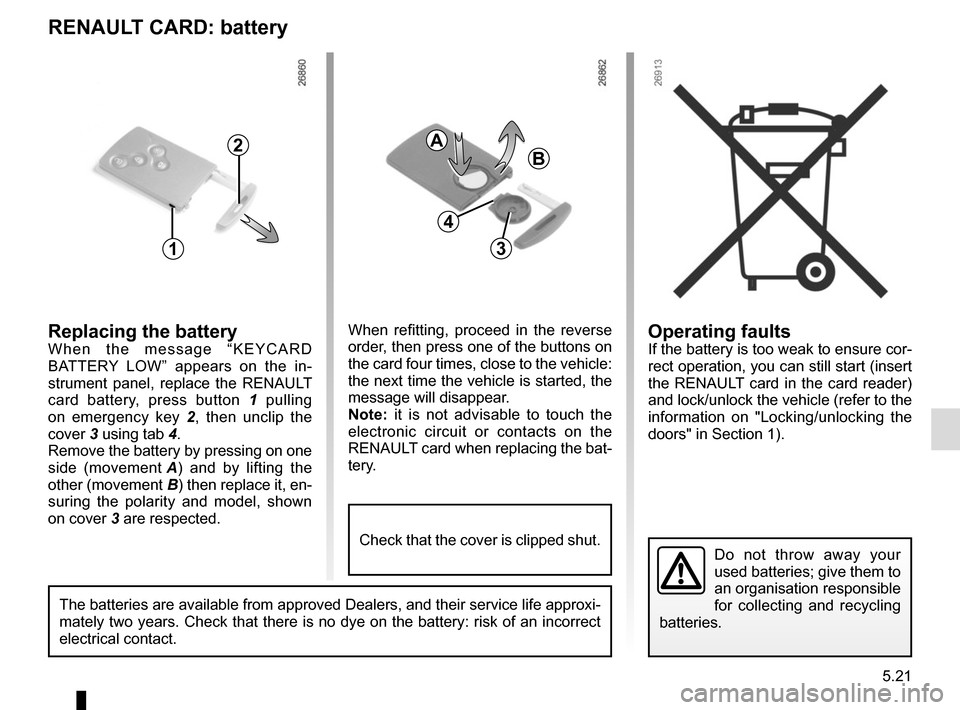
5.21
Operating faultsIf the battery is too weak to ensure cor-
rect operation, you can still start (insert
the RENAULT card in the card reader)
and lock/unlock the vehicle (refer to the
information on "Locking/unlocking the
doors" in Section 1).
RENAULT CARD: battery
Replacing the batteryWhen the message “KEYCARD
BATTERY LOW” appears on the in-
strument panel, replace the RENAULT
card battery, press button 1 pulling
on emergency key 2 , then unclip the
cover 3 using tab 4.
Remove the battery by pressing on one
side (movement A) and by lifting the
other (movement B) then replace it, en-
suring the polarity and model, shown
on cover 3 are respected.
Do not throw away your
used batteries; give them to
an organisation responsible
for collecting and recycling
batteries.
1
2
When refitting, proceed in the reverse
order, then press one of the buttons on
the card four times, close to the vehicle:
the next time the vehicle is started, the
message will disappear.
Note: it is not advisable to touch the
electronic circuit or contacts on the
RENAULT card when replacing the bat-
tery.
A
B
3
The batteries are available from approved Dealers, and their service lif\
e approxi-
mately two years. Check that there is no dye on the battery: risk of an \
incorrect
electrical contact.
4
Check that the cover is clipped shut.
Page 204 of 248

5.22
Radio location 1
Unclip the blanking cover. The aerial, +
and – supply and speaker wire connec-
tions are located behind it.
Door speakers 2
To install any equipment, please con-
sult an authorised dealer.
FITTING A RADIO
1
2– In all cases, it is very important to
follow the manufacturer’s instruc-
tions carefully.
– The specifications of the brack- ets and wires (available from our
network) vary depending on the
equipment level of your vehicle
and the type of radio.
Consult an approved Dealer to find out the correct part number.
– No work may be carried out on the vehicle’s electrical or radio
circuits, except by approved
dealers: an incorrectly connected
system may result in damage
being caused to the electrical
equipment and/or the compo-
nents connected to it.
Page 205 of 248
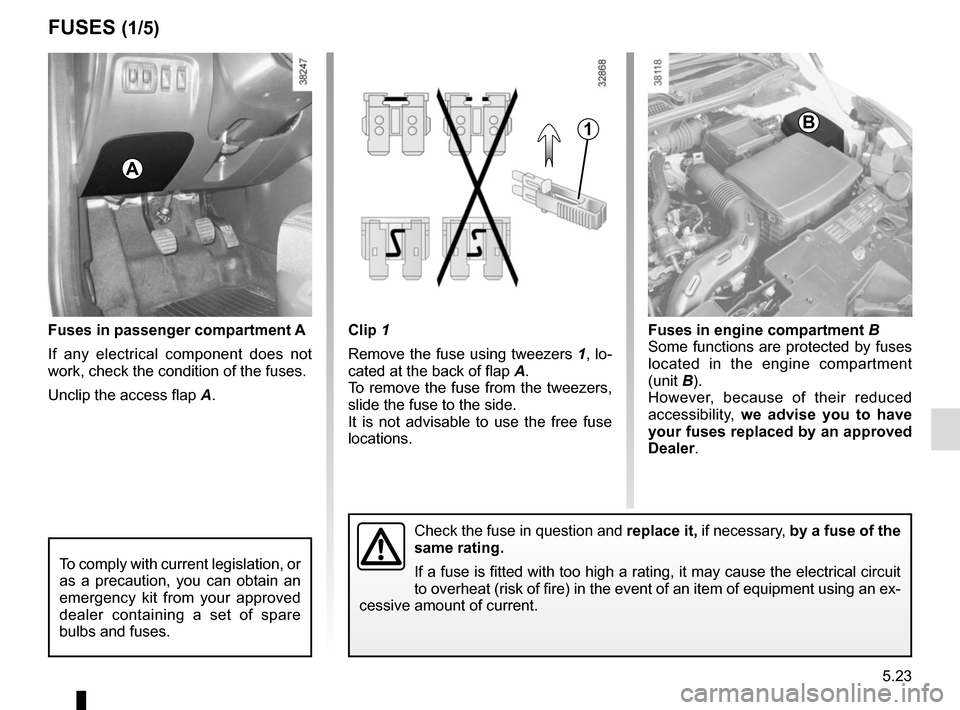
5.23
Clip 1
Remove the fuse using tweezers 1, lo-
cated at the back of flap A.
To remove the fuse from the tweezers,
slide the fuse to the side.
It is not advisable to use the free fuse
locations.Fuses in passenger compartment A
If any electrical component does not
work, check the condition of the fuses.
Unclip the access flap A.
FUSES (1/5)
Fuses in engine compartment B
Some functions are protected by fuses
located in the engine compartment
(unit B).
However, because of their reduced
accessibility, we advise you to have
your fuses replaced by an approved
Dealer .
1
A
B
To comply with current legislation, or
as a precaution, you can obtain an
emergency kit from your approved
dealer containing a set of spare
bulbs and fuses.
Check the fuse in question and replace it, if necessary, by a fuse of the
same rating.
If a fuse is fitted with too high a rating, it may cause the electrical \
circuit
to overheat (risk of fire) in the event of an item of equipment using \
an ex-
cessive amount of current.
Page 206 of 248
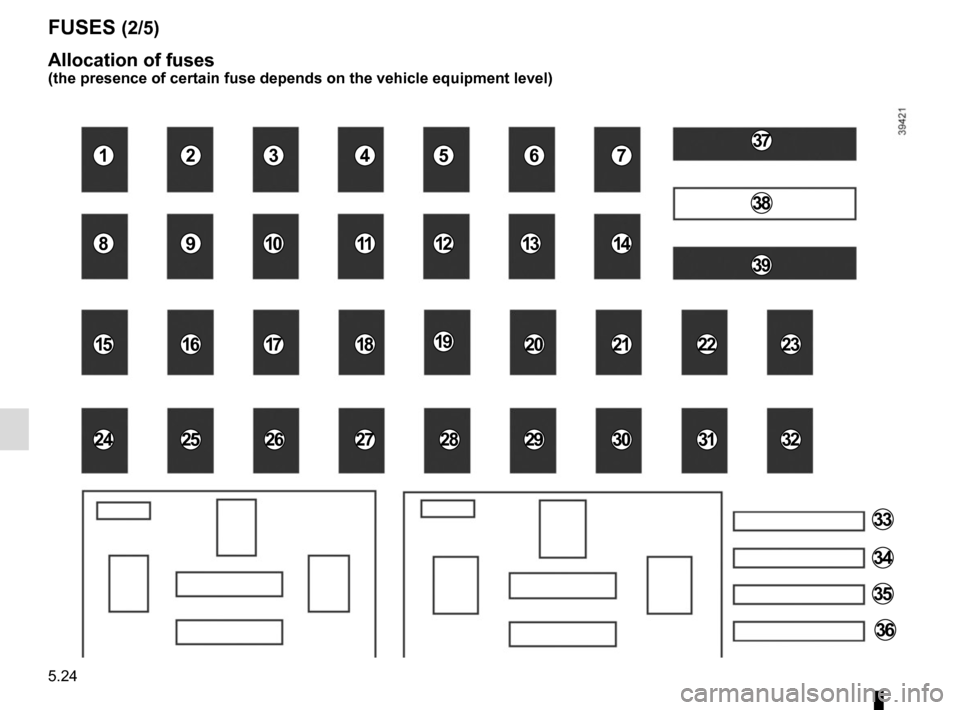
5.24
FUSES (2/5)
Allocation of fuses
(the presence of certain fuse depends on the vehicle equipment level)
1
8
15
24
2
9
16
25
3
10
17
26
4
11
18
27
5
12
19
2829
6
13
2022
30
7
14
2123
3231
33
34
35
36
37
38
39
Page 207 of 248
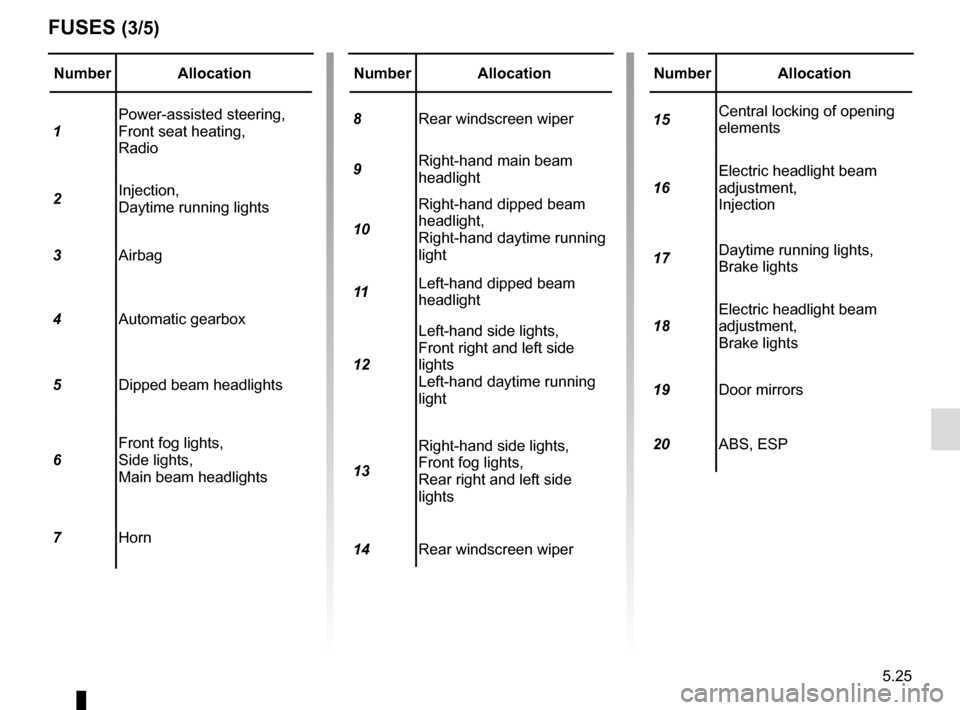
5.25
Number Allocation
1 Power-assisted steering,
Front seat heating,
Radio
2 Injection,
Daytime running lights
3 Airbag
4 Automatic gearbox
5 Dipped beam headlights
6 Front fog lights,
Side lights,
Main beam headlights
7 Horn
FUSES (3/5)
Number Allocation
8 Rear windscreen wiper
9 Right-hand main beam
headlight
10 Right-hand dipped beam
headlight,
Right-hand daytime running
light
11 Left-hand dipped beam
headlight
12 Left-hand side lights,
Front right and left side
lights
Left-hand daytime running
light
13 Right-hand side lights,
Front fog lights,
Rear right and left side
lights
14 Rear windscreen wiperNumber Allocation
15 Central locking of opening
elements
16 Electric headlight beam
adjustment,
Injection
17 Daytime running lights,
Brake lights
18 Electric headlight beam
adjustment,
Brake lights
19 Door mirrors
20 ABS, ESP
Page 208 of 248
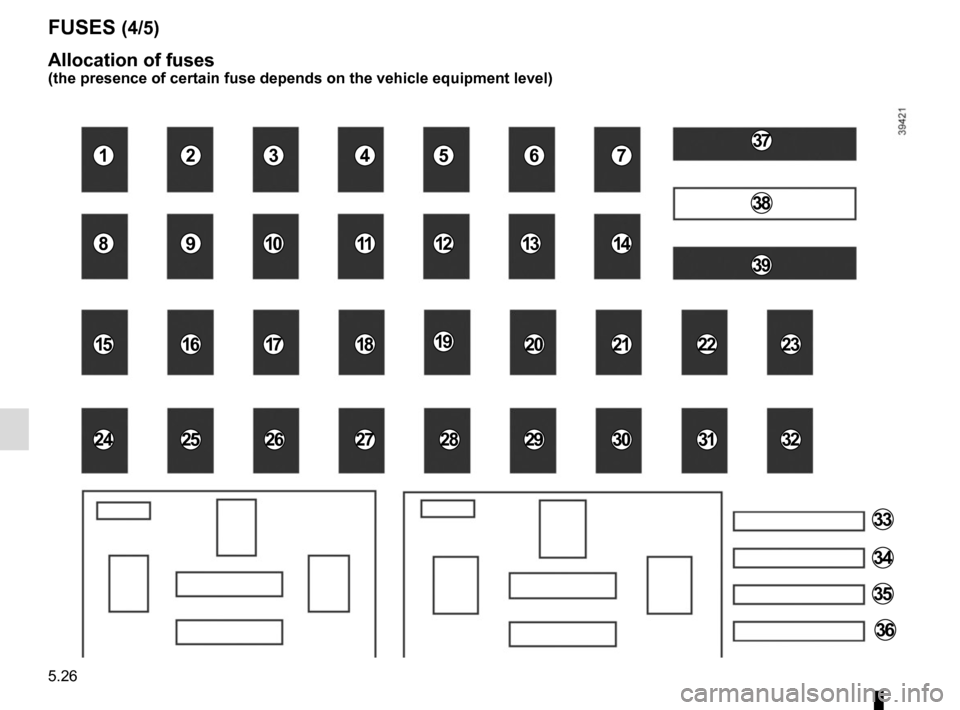
5.26
FUSES (4/5)
Allocation of fuses
(the presence of certain fuse depends on the vehicle equipment level)
1
8
15
24
2
9
16
25
3
10
17
26
4
11
18
27
5
12
19
2829
6
13
2022
30
7
14
2123
3231
33
34
35
36
37
38
39
Page 209 of 248
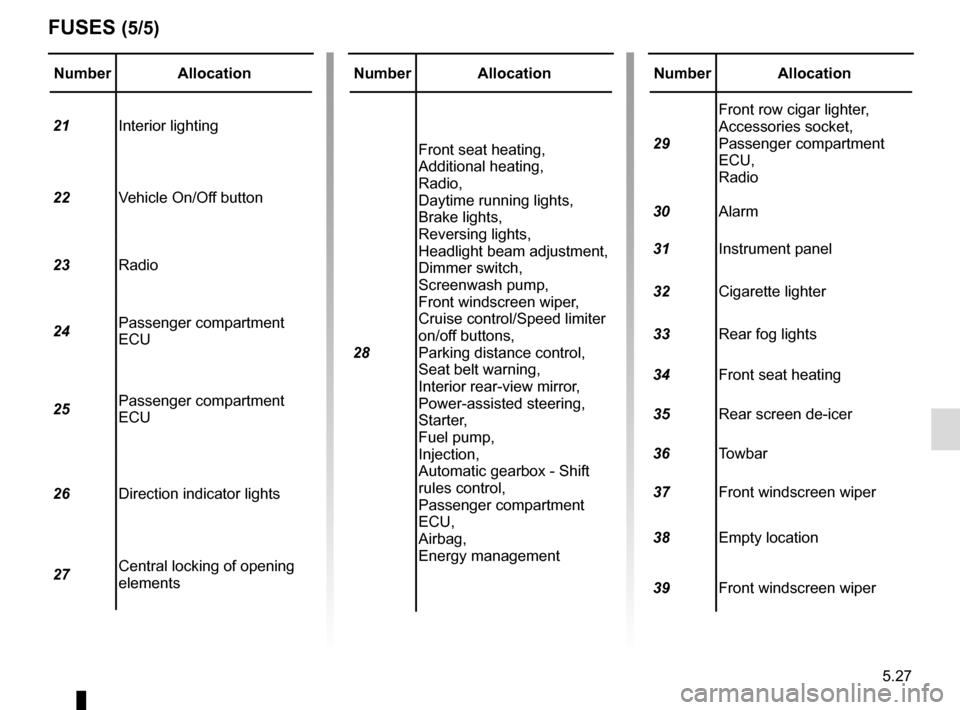
5.27
Number Allocation
21 Interior lighting
22 Vehicle On/Off button
23 Radio
24 Passenger compartment
ECU
25 Passenger compartment
ECU
26 Direction indicator lights
27 Central locking of opening
elements
FUSES (5/5)
Number Allocation
28 Front seat heating,
Additional heating,
Radio,
Daytime running lights,
Brake lights,
Reversing lights,
Headlight beam adjustment,
Dimmer switch,
Screenwash pump,
Front windscreen wiper,
Cruise control/Speed limiter
on/off buttons,
Parking distance control,
Seat belt warning,
Interior rear-view mirror,
Power-assisted steering,
Starter,
Fuel pump,
Injection,
Automatic gearbox - Shift
rules control,
Passenger compartment
ECU,
Airbag,
Energy managementNumber Allocation
29 Front row cigar lighter,
Accessories socket,
Passenger compartment
ECU,
Radio
30 Alarm
31 Instrument panel
32 Cigarette lighter
33 Rear fog lights
34 Front seat heating
35 Rear screen de-icer
36 Towbar
37 Front windscreen wiper
38 Empty location
39 Front windscreen wiper
Page 210 of 248
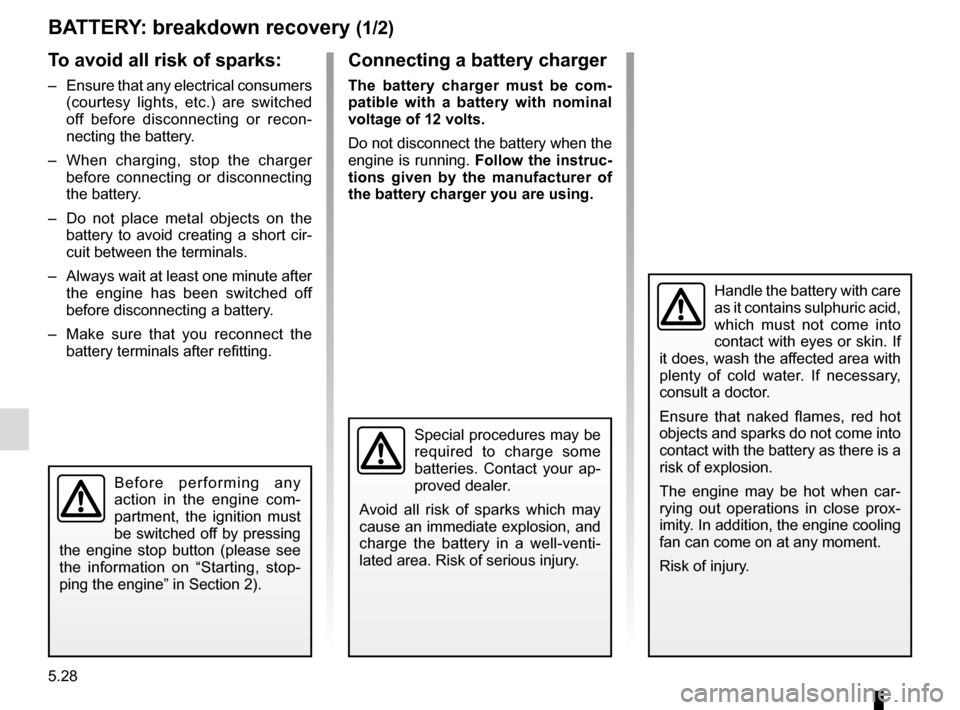
5.28
BATTERY: breakdown recovery (1/2)
To avoid all risk of sparks:
– Ensure that any electrical consumers (courtesy lights, etc.) are switched
off before disconnecting or recon-
necting the battery.
– When charging, stop the charger before connecting or disconnecting
the battery.
– Do not place metal objects on the battery to avoid creating a short cir-
cuit between the terminals.
– Always wait at least one minute after the engine has been switched off
before disconnecting a battery.
– Make sure that you reconnect the battery terminals after refitting.
Connecting a battery charger
The battery charger must be com-
patible with a battery with nominal
voltage of 12 volts.
Do not disconnect the battery when the
engine is running. Follow the instruc-
tions given by the manufacturer of
the battery charger you are using.
Special procedures may be
required to charge some
batteries. Contact your ap-
proved dealer.
Avoid all risk of sparks which may
cause an immediate explosion, and
charge the battery in a well-venti-
lated area. Risk of serious injury.
Handle the battery with care
as it contains sulphuric acid,
which must not come into
contact with eyes or skin. If
it does, wash the affected area with
plenty of cold water. If necessary,
consult a doctor.
Ensure that naked flames, red hot
objects and sparks do not come into
contact with the battery as there is a
risk of explosion.
The engine may be hot when car-
rying out operations in close prox-
imity. In addition, the engine cooling
fan can come on at any moment.
Risk of injury.
Before performing any
action in the engine com-
partment, the ignition must
be switched off by pressing
the engine stop button (please see
the information on “Starting, stop-
ping the engine” in Section 2).